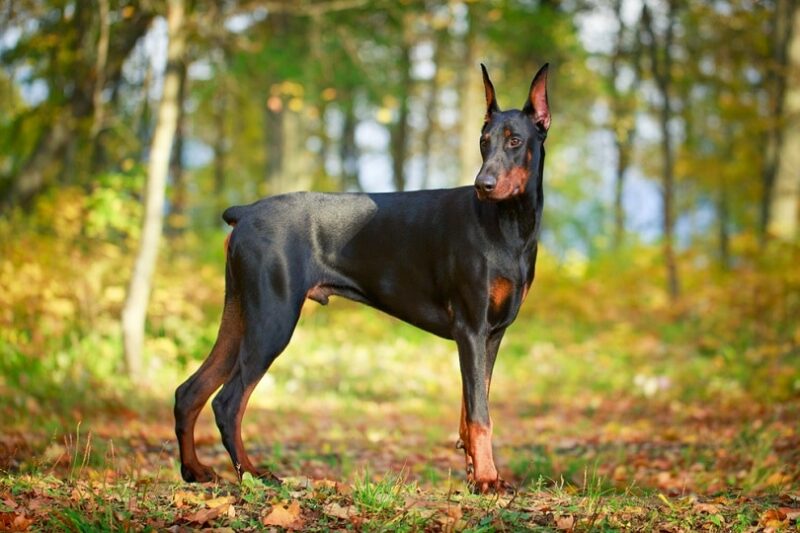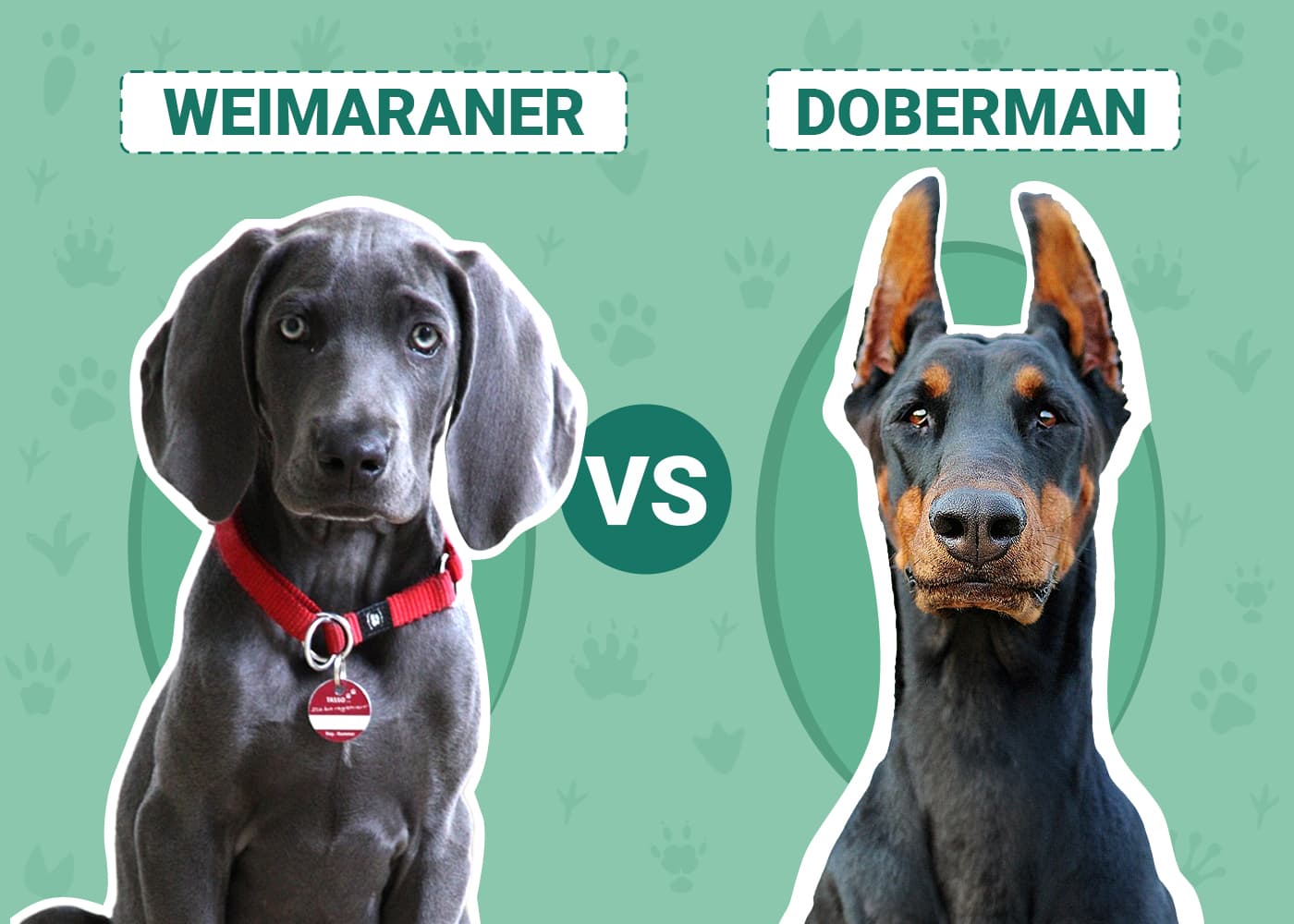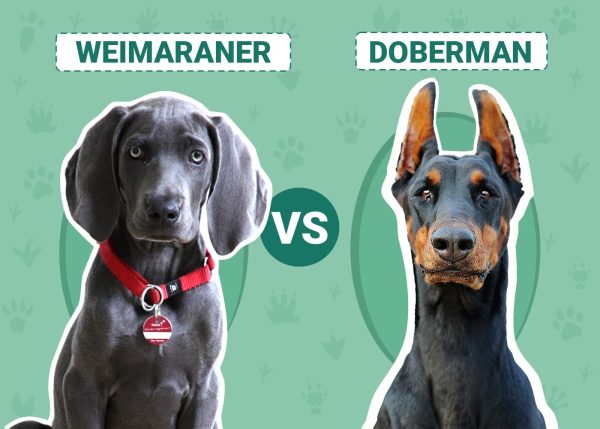Click to Skip Ahead
The Weimaraner and Doberman have a lot in common in both appearance and personality. They’re both large dogs that originated in Germany and have slender, athletic bodies, wedge-shaped heads of a similar structure, an intense expression, and soft, floppy ears (when not cropped to stand upright, as is unfortunately sometimes the case with Dobermans) and are both fearless, highly intelligent, and friendly.
That being said, there are a few differences, as well. If you’re not sure which breed to choose, this post puts them both side by side to make the similarities and differences between them clearer. We hope you find this useful when deciding which breed is right for you.

Visual Differences

At a Glance
- Average height (adult): 23–27 inches
- Average weight (adult): 55–90 pounds
- Colors: Blue, gray, silver gray
- Lifespan: 10–13 years
- Exercise: 2 hours minimum per day
- Grooming needs: Low
- Family-friendly: Often very
- Other pet-friendly: Often
- Trainability: Highly trainable, needs a lot of consistency
- Average height (adult): 24–28 inches
- Average weight (adult): 60–100 pounds
- Lifespan: 10–12 years
- Colors: Black and rust, blue and rust, red and rust, fawn and rust, white
- Exercise: 2 hours minimum per day
- Grooming needs: Low
- Family-friendly: Often very
- Other pet-friendly: Often
- Trainability: Very smart, quick to learn, can be pushy with inexperienced owner
Weimaraner Overview

Now, let’s take a closer look at the beautiful and almost ethereal Weimaraner, a dog that never fails to turn heads wherever they go. This dog breed belongs to the sporting group.
Appearance
The Weimaraner is a truly beautiful canine with a very unique and distinctive appearance. Known to some as the “gray ghost”, Weimaraners come in three colors—blue, gray, and silver gray. They have a long and “aristocratic” head as per the AKC’s breed description, a deep chest, a slender tucked-in waist, long, lithe legs, and floppy ears.
Males are typically between 25 and 27 inches tall, and females are between 23 and 25 inches tall. Dobermans can grow to be slightly bigger. Weimaraners are also slightly lighter, weighing up to 90 pounds.
Personality / Character
Weimaraners are known for being friendly, courageous, intelligent, and curious dogs with a great deal of energy. According to the AKC, Weimaraners are often very affectionate with family and very good with young children, though this of course depends on how well the Weimaraner has been socialized and whether children have been taught to respect them, as with any dog breed.
If you have small children, it’s a good idea to always supervise your Weimaraner around them as these are large dogs that may accidentally knock them down while playing. As for other dogs and pets, it helps to raise a Weimaraner alongside them from an early age. As for adopted Weimaraners, you can ask the shelter or rehoming agency how well they get along with other animals.
They’re also said to be very confident and assertive dogs, which may make them a bit of a handful for inexperienced owners.
Training
Weimaraners are very intelligent, trainable dogs that pick things up easily, though this can mean that they pick up bad habits easily, too. As such, they need a firm but kind leader and plenty of consistency to prevent them from slipping into bad habits. If you’re new to dog parenting and training, we’d recommend training/obedience classes so you can pick up some tips from the pros.
Exercise Needs
As a high-energy breed, Weimaraners require around 2 hours of exercise per day to be mentally and physically stimulated enough. They enjoy nice, long walks and being able to run and really stretch their legs. Playtime with you is another important part of a Weimaraner’s daily routine.
A bored Weimaraner is an unhappy and possibly destructive Weimaraner, so if you’re planning on getting one, make sure you can commit to the amount of exercise they need every day.

Health & Care
As with any breed, Weimaraners are susceptible to health problems. Though this doesn’t mean your Weimaraner will suffer from any breed-specific conditions, it’s a good idea to keep an eye out for symptoms of the following:
In terms of grooming, Weimaraners have short coats that shed a bit throughout the year and more during shedding seasons. Their needs in this department are generally low—brushing them weekly should be fine, though you can do it more if you want to.
Like all dogs, they need to have their claws trimmed to prevent overgrowth and their ears should be checked regularly to make sure they’re clean. Regular teeth brushing is also important.
Suitable for:
Weimaraners are best suited to active families who can commit to their exercise needs and training and can give them all the love and attention they need. These are very loving dogs that tend to stick to their families like glue.
Furthermore, they may be better suited to a family with older children rather than very small children—not due to aggression, but more because the Weimaraner may unintentionally knock small children over if they get a bit too enthusiastic.

Doberman Overview

If you’ve got your eye on a svelte and majestic Doberman—also known as a Doberman Pinscher—here are the basics on this wonderful and historical breed. This breed belongs to the working group.
Appearance
Svelte, sleek, and noble in appearance, the Doberman has a powerful, confident stance and an alert expression. Like the Weimaraner, they have deep chests, tucked-in waists, and long, slender legs. The neck is long, arched, and muscular, and their heads are described as “long and dry” by the AKC’s breed standard.
One way in which Dobermans differ greatly from Weimaraners is in their coat colors. While Weimaraners can only be blue, gray, or silver-gray, Dobermans can be black and rust blue and rust, red and rust, fawn and rust, or white, though white is a non-standard color.
Personality
The noble and dignified Doberman is another athletic and high-energy breed that may look tough but is often as soft as cookie dough underneath, particularly with their families. Like the Weimaraner, the AKC classifies Dobermans as “lovely dovey” in terms of how affectionate they are with their families and are said to be good with children as long as they’ve been raised properly.
Since they were bred to be working dogs, the Doberman’s solid work ethic has never left. They love having a job to do and need plenty of mental stimulation to prevent boredom.
Training
Like the Weimaraner, the Doberman is very intelligent and doesn’t find it difficult to learn the ropes. That said, they might be better suited to a more experienced dog owner rather than a first-time owner because they’re prone to being pushy and difficult to manage if not given firm but fair boundaries.
If you’re a new dog parent, though, you could always enlist the help of a professional trainer or go to obedience classes. Dobermans also respond well to reward-based training—something to bear in mind.
Exercise Needs
The Doberman needs a good 2 hours of exercise per day at a minimum. These are very athletic dogs that need an outlet for their pent-up energy—if they don’t get this, they may become destructive. Like the Weimaraner, they’re best suited to a family who can give them all the exercise they need.

Health & Care
All breeds are prone to certain conditions and the Doberman is no exception. The health conditions Dobermans are susceptible to include:
- Hip dysplasia
- Dilated Cardiomyopathy
- Progressive Retinal Atrophy
- Von Willebrand’s Disease
- Albinism
- Hypothyroidism
In terms of grooming, Dobermans don’t shed an awful lot, but a good brush at least once a week—more during shedding seasons—is a good way to keep their coats in optimal condition. In addition to this, it’s crucial to avoid letting their nails grow too long. They also need regular ear checks and teeth brushing.
Suitable for:
When raised and socialized properly, the Doberman makes a wonderful companion for all kinds of active families. That said, they might be best suited to experienced owners or at least those committed to working with professional trainers or going to obedience classes.
This is because they’re powerful, confident dogs that might run rings around a well-meaning but inexperienced owner when it comes to training.
Which Breed Is Right for You?
Well-socialized and trained Weimaraners and Dobermans both make excellent family dogs that will give you love and affection in abundance—both are typically good with children and loving with family and have similar personalities. Both breeds are highly active and need plenty of daily exercise, so whichever breed you choose, you’ll need to be able to make that work.
We think both breeds would do well with an experienced dog owner due to their energy and training needs. If you’re a first-time owner, be prepared to be kind, firm, and very consistent with your Weimaraner or Doberman, and consider recruiting a professional for help with training.
Featured Image Credit: Top – David Pegzlz, Shutterstock | Bottom – DSD, Pexels











